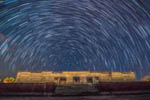HOME
Mitla archeological site
Oaxaca, Mexico
© Stéphane Guisard, Los Cielos de América
Credits:
- Daniel Flores and Barbara Pichardo, Instituto de Astronomia of the Universidad Nacional Autónoma de México (UNAM).
- Dr. Pedro Francisco Sánchez Nava (Presidente del Consejo de Arqueologia) / Instituto Nacional de Antropología e Historia (INAH).
- Stéphane Guisard (Picture and ©) / Los Cielos de América.
Mitla is one of many well-preserved archeological sites of the Oaxaca Valley, where the dry climate has conserved sites as old as 10,000 years. This valley was settled by the Zapotecs who over the centuries developed a hierarchical society governed by kings and nobles. While the valley was relatively isolated, the Zapotecs did have contacts with other Mesoamerican peoples. By the time the Spanish arrived, the Zapotec state had a population of over 500,000, sophisticated construction techniques, a writing system, two calendar systems and agriculture that included the growing of maize, beans, squash, and chili peppers, using irrigation and terraces in the mountains to grow food for a mostly urban population.
Mitla itself was inhabited at least since the Classic Period (100-650 CE) and perhaps from as early as 900 BCE. It began as a fortified village on the outer edge of the valley and later became the main religious center for the area. The Mixtecs took control of the area around 1000 CE, although the area remained populated by the Zapotec. The city reached its height and largest size between 750 and 1521, with both Zapotec and Mixtec influences in its architecture during that time. Mitla is one of the pre-Columbian sites that represent the Mesoamerican belief that death was the most consequential part of life after birth. It was built as a gateway between the world of the living and the world of the dead.
Today the archeological consists of five groups of buildings called the South Group, the Adobe Group, the Arroyo Group, the Columns or Palace Group and the Church or North Group. The main distinguishing feature of Mitla is the intricate mosaic fretwork and geometric designs, also called friezes, that profusely adorn the walls of both the Church and Columns groups.
The pictures I propose here were taken at the column Group and the Church Goup.
(text from Wikipedia)




The Palace, visible on this picture, is the main building of the Mitla 'columns group'. It measures 120 by 21 feet (36.6 by 6.4 m). This picture was taken from the courtyard and pointing the North. Multiple exposures were taken and added to show the star trails due to the Earth rotation. The center of these trails shows the celestial north Pole. The bright star near this center is the polar star.

Also part of the Palace Goup, the "PatioD" is a small symetrical square room with four doors and very rich friezes decoration."

Mitla, The Church Group, Patio Norte.
